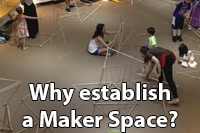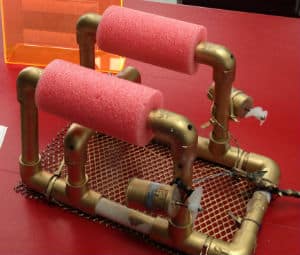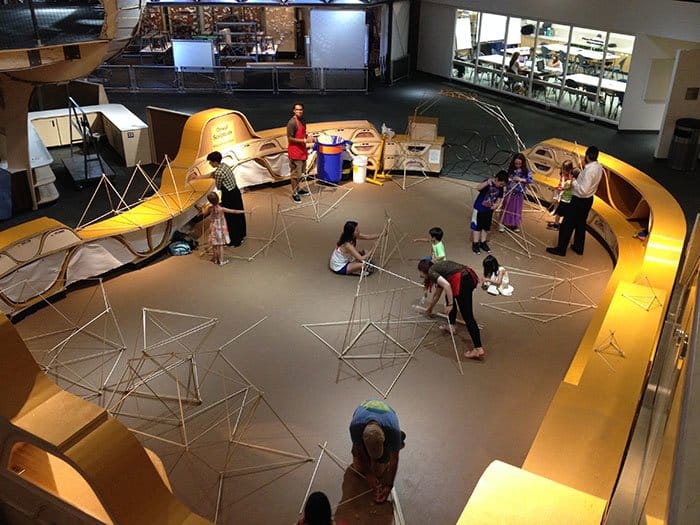
Good question!
We love the Maker movement! The popularity of Maker spaces, Maker fairs, Maker nights and more has just grown and grown from a grassroots movement to a worldwide phenomenon to bring Science, Technology, Engineering, Art & Mathematics together where students can tinker and explore new ways of using materials and tech creatively. Using open source software plus materials from electronics and hardware stores or even second-hand materials that can be re-purposed, the Maker movement is fueled by a inquisitive breed of kids and adults intent on creating DIY projects that are fun and aim to solve problems that commercial products either don’t address or are just way over budget. Sometimes its not even that; it can often just mean creating something just for the sheer pleasure of finding out “Can this be done?”. Plus, it’s fun to boot! So the question is, can teachers create their own Maker labs in their school? What are the barriers and what can you do to overcome them?
Most teachers will instantly recognise the constructivist roots in this blend of tech hardware & hacker culture. As most readers would be aware, kids learn best with their hands (and so do adults for that matter). Whilst it’s great to learn how science works from a theoretical perspective, it’s only when we get our hands dirty that we explore and make connections with our world. Of course teaching the scientific method is incredibly important when it comes to teaching science in school, however running the classic science experiments just like you read in the textbook doesn’t address science’s hidden partners… creativity and imagination.

Diving submersible Maker project – Great Lakes Science Center
Place yourself in your student’s shoes just for a minute: imagine that you’re an enthusiastic 11 year old ready to start putting ideas gained from class into the practice only you haven’t got an outlet to tinker with things. Sure, it’s great to be able to run structured science experiments under the watchful guidance of your teacher, but you never get to truly are able to express your own thoughts and ideas to apply the concepts in new and meaningful ways if this is all you get to do. You’d eventually start to disengage or at the very least begin to adjust your attitude to eventually seeing science only a rigid methodology rather than an exploration of the boundaries of human knowledge. Not a great recipe for creating an engaged community in the sciences! The Maker movement directly counteracts this thinking, as it allows students to safely explore what works and what doesn’t work at their own pace. This is highly important…learning to fail is just as important as striving to succeed after all!
The classic line is this… we are all makers. We all like to create things. We all like to build things. We all like to personalize things. The Maker movement just provides an avenue and almost permission to act on these fundamental drivers of human endeavour.
As the pedigree of the maker movement is aligned directly with working with the community, creating a Maker space in your school could bring highly engaged adults and kids together in a learning environment that they’ll care for. The advantages of establishing such a venture at your school could well go beyond student STEM learning outcomes; perhaps it could be another way if your school being a focal point in your locality. Plus, it might also help drive both departmental and media interest in your initiative too! Perhaps you’re raring to go but you know it might be a bit harder to convince your team. Maybe it could be worth your time playing Dale Dougherty’s TED talk ‘We are all Makers’ for inspiration at your next school staff meeting?
Creating a Maker space in your school would go a long way to addressing the curiosity and inquisitiveness in your students. Of course, you will need to do your due diligence in terms of safety and child protection prior to establishing a Maker space, but I would argue that if you have a spare room in your school what have you got to lose? You could even use this as a way of partnering with your local high school too.
Maker labs are effectively a natural extension of a science club with an engineering twist. The cost of materials is entirely dependent on what you want to achieve with your Maker space. I’ve seen construction materials consist of cardboard to recycled electronics through to complete pre-packaged startup kits to get you going. It just comes down to how much time and money you wish to spend and more importantly, motivation! Perhaps this might even be an opportunity for students to learn to prepare and implement a business case and marketing it to the community and industry leaders for financial support or sponsorship? Below is a list of some of the commonly used materials that go beyond simple craft materials, certainly this is just the tip of the iceberg:
- 3D printing using 3D scanners
- DIY electronics and old phones
- Arduino & Raspberry Pi
- Open source code and programs such as Scratch by MIT or through searchable platforms such as Sourceforge & GitHub.
Whilst it would be great to have the fancy support materials like 3D printers and so on, in reality, the materials don’t have to be prohibitively expensive. All you have to do is consider how to re-purpose materials around you. You might be wondering at what other support resources that might be available? Well, apart from the curiosity and inventiveness of your fellow amateur STEAM enthusiasts, there is an entire branch of media and associated businesses have developed as a natural progression of the Maker movement including Makezine.com, Makers Empire and more. You can even check out a feature presentation called “Maker: a documentary on the maker movement”.
Worldwide, science and technology museums have been rapidly establishing Maker spaces in response to the growing demand. Whilst on a Churchill Fellowship on science education video conferencing a couple of years ago, I was privileged to visit the New York Hall of Science where a Maker Lab is placed directly in the middle of the main auditorium to encourage to come and work with odds and ends to complete engineering challenges in their own way. The kids shown in the picture below were completely engrossed in their tasks, so much so that it was clear that one of the parents was struggling to get their kids to move on to other exhibits!

New York Hall of Science Maker Space
Without a doubt there will be some readers would rather just visit and established Maker space.
Well, there are quite a few options to choose from. Everything from a local Maker fair in Australia to global Maker campaigns can be accessed with just a click of a button. Here’s just a few
Regardless of what your position is on establishing such a room at your school, it’s difficult to ignore the potential for these informal activities to positively impact learning in your school. Even if you just grab one component of the Maker movement and make it yours in your classroom you’ll go a long way to inspiring your students to think, create, explore and apply knowledge. Isn’t that what we do as educators? Sure is!
Happy teaching,


























Comments